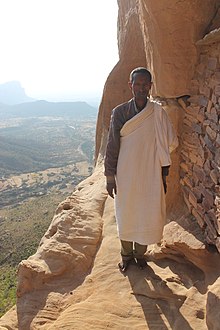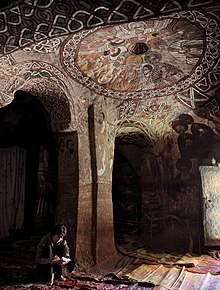Church in Ethiopia
| Abuna Yem'ata Guh | |
|---|---|
| ኣቡና የማታ ጉሕ | |
 Monk standing in front of Abuna Yemata Guh's entrance Monk standing in front of Abuna Yemata Guh's entrance | |
 | |
| 13°54′55″N 39°20′35″E / 13.9152603°N 39.343071°E / 13.9152603; 39.343071 | |
| Country | Ethiopia |
| Denomination | Ethiopian Orthodox |
| History | |
| Status | Church |
| Dedication | Saint Abba Yem'ata |
| Architecture | |
| Functional status | Active |
| Architectural type | Chapel |
| Style | Monolithic |
| Specifications | |
| Materials | Sandstone |
Abuna Yemata Guh is a monolithic church located in the Hawzen woreda of the Tigray Region, Ethiopia. It is situated at a height of 2,580 metres (8,460 ft) and has to be climbed on foot to reach. It is notable for its spectacular location, its architecture and dome dating back to the sixth century, and its 15th century wall paintings.
About
The church is one of the "35-odd rock-hewn churches the largest concentration anywhere in Ethiopia." It is situated in the erstwhile Gar'alta district (woreda). The entrance is reached by a steep and hazardous ascent with hand and footholds in the rock. Visitors have to cross a natural stone bridge with a sheer drop of approximately 250 m (820 ft) on either side, and thereafter a final narrow wooden footbridge. The standing pillars are made up of Enticho and Adigrat Sandstones, which are the last erosional remnants of a sandstone formation that once covered the Precambrian basement. Although Abuna Yemata Guh is the most inaccessible place of worship in the world, priests have not recorded deaths from the climb.
History
According to a local legend, the church was hewn during the sixth century, and dedicated to Abuna Yemata (also referred to as Abba Yem'ata), one of the Nine Saints. The Nine Saints are traditionally believed to have originated from Rome, Constantinople, and Syria between the end of the fifth and beginning of the sixth centuries.
Paintings in the church

Owing to the dry climate of the church, the paintings on the walls and domes of the church are well-preserved. The design of the traceries in the church replicates those found in nearby churches of Gher'alta, such as Debre Tsion church (which houses more paintings depicting figures from the Old Testament than from the New Testament).
The paintings, themed around the nine saints and twelve apostles, includes icons that are in the form of diptychs and triptychs, are by tradition said to date back to the sixth century, although scholars have placed their creation to the latter half of the 15th century. A 2016 study analyzing the paintings using X-ray fluorescence broadly supports the 15th century date, showing that most of the pigments used were sourced locally and that no underlying layer of paint existed, with the exception of the painting of Mary, where evidence of retouching was identified.
See also
References
- The Rough Guide to Ethiopia (1 ed.). UK: Rough Guides. 2 March 2015. p. 160. ISBN 9780241181850.
- Buxton, David (1970). The Abyssinians (1. publ. ed.). London: Thames & Hudson. p. 145. ISBN 9780500020708.
- ^ Gebremariam, Kidane Fanta; Kvittingen, Lise; Nicholson, David Graham (28 September 2016). "Multi-analytical investigation into painting materials and techniques: the wall paintings of Abuna Yemata Guh church". Heritage Science. 4 (1). doi:10.1186/s40494-016-0101-6. hdl:11250/2652856.
- Briggs, Philip (2002). Ethiopia (3rd ed.). Chalfont St. Peter: Bradt. p. 250. ISBN 978-1841620350.
- "Ethiopia's living churches – in pictures". The Guardian. 14 December 2017.
- Scott, Audrey; Noll, Daniel (22 August 2014). "In Ethiopia, an adrenaline-filled act of faith". BBC Online.
- ^ Williams, Frances M. (2016). Understanding Ethiopia: Geology and Scenery (illustrated ed.). Springer. p. 343. ISBN 9783319021805.
- "Abuna Yemata Guh -- Reaching for the Heavens" Africa Geographic Magazine website, 28 March 2018 (last visited 23 May 2024)
- Votrin, Valery (January 2005). "The Orthodoxy and Sustainable Development a Potential for Broader Involvement of the Orthodox Churches in Ethiopia and Russia". Environment, Development and Sustainability. 7 (1): 9–21. doi:10.1007/s10668-003-5053-9. S2CID 154784459.
- Hable Selassie, Sergew (1972). Ancient and medieval Ethiopian history to 1270. Printed by United Printers. p. 370. OCLC 868317.
- Fitzgerald, Mary Anne; Marsden, Philip. The Living Churches of an Ancient Kingdom. American University in Cairo Press. p. 536. ISBN 9789774168437.
- Henze, Paul B. (2001). Layers of time a history of Ethiopia (2nd impr. ed.). London: Hurst. p. 79. ISBN 9781850653936.
External links
 Media related to Abuna Yemata Guh at Wikimedia Commons
Media related to Abuna Yemata Guh at Wikimedia Commons